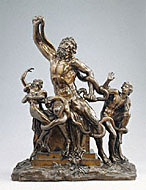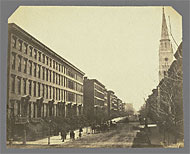Principles of Design
The principles of design describe the ways that artists use the elements of art in a work of art.
Below are a few examples of principles of design, which are illustrated in works of art in the Museum's collection. Learn about the elements of art here.
Download a student handout containing a list of the principles of design and their definitions. (PDF, 190KB)
Below are a few examples of principles of design, which are illustrated in works of art in the Museum's collection. Learn about the elements of art here.
Download a student handout containing a list of the principles of design and their definitions. (PDF, 190KB)
Balance
Balance is the distribution of the visual weight of objects, colors, textures, and space. If the design was a scale, these elements should be balanced to make a design feel stable.

|
|
Symmetrical balance conveys a sense of stability. In this example, a single large figure in the center is flanked by a smaller figure on either side. The shape of the artwork itself is also symmetrical—a vertical line bisecting the image would create two equal halves that are mirror images of one another.

|
|
Asymmetrical balance often conveys a sense of movement since the elements of the composition are unbalanced. In this example, the artist used organic forms to create a composition that mimics the movement of vines growing in an unordered fashion around the clock face.
Emphasis
Emphasis is the part of the design that catches the viewer's attention. Usually the artist will make one area stand out by contrasting it with other areas. The area could be different in size, color, texture, shape, etc.

|
|
In this sculpture, the central figure stands out due to his relative size and position above the other figures. The diagonal lines of the contorting bodies and the serpent lead the viewer's eye to the figure, further emphasizing him and conveying the intensity of his struggle against the snake's stranglehold.
Movement
Movement is the path the viewer's eye takes through the work of art, often to focal areas. Such movement can be directed along lines, edges, shape, and color within the work of art.

|
|
In this photograph the diagonal lines lead the eye into the space to the point where the lines converge.
|
||||||||||||||||||||||||||||||||||||||||||||